Page is loading ...

27
Table of Contents
Page
Important Information
❑ Notes on disposal 28
❑ Before connecting your
new appliance 28
❑ Appliance safety considerations 29
Before Using Your Appliance for the
First Time
❑ Preliminary cleaning 29
❑ Initial burn-in 29
Introducing: Your New Cooker
❑ Control panel overview 30
❑ Accessories 31
❑ Slide-in levels 31
Baking and Roasting
❑ Description of Oven Features 32
❑ Switching the oven ON and OFF 33
❑ Baking 34–37
❑ Roasting 38+39
❑ Circulating air grilling 40+41
Grilling 42+43
Thawing / Drying / Heating 44+45
Cooking Tips and Helpful Hints 46
Page
Cleaning and Care
❑ Important cleaning basics 47
❑ Enamel and glass 47
❑ Stainless steel front 47
❑ Oven interior 47
❑ Removing/installing the oven door 48
❑ Removing the suspend grids 48
Service and Repair Information 49
Trouble-shooting Guide 50

28
Notes on disposal
❑ Old appliances still have some residual
value. An environment-friendly method
of disposal will ensure that valuable raw
materials can be recovered and used
again.
Before you dispose of your old
appliance, make sure that it has been
rendered inoperable.
❑ Your new appliance was protected by
suitable packaging while it was on its
way to you. All materials used for this
purpose are environment-friendly and
suitable for recycling. Please make a
contribution to protecting the
environment by disposing of the
packaging appropriately.
Up-to-date information concerning
options for disposing of your old
appliance and the packaging from the
new one can be obtained from your
retailer or local government office.
Before connecting your new
appliance
❑ Before using your new appliance, please
read these Instructions for Use carefully.
They contain important information
concerning your personal safety as well
as on use and care of the appliance.
❑ The Instructions for Use apply to several
versions of this appliance. Accordingly,
you may find descriptions of individual
features that do not apply to your
specific appliance.
❑ Please keep the operating and
installation instructions in a safe place;
this important documentation may also
be of use to a possible subsequent
owner.
❑ Do not use the appliance if it is
damaged in any way.
❑ Installation and connection of the
appliance should be performed
according to the instructions and
connection diagram provided, and
should be entrusted to a licensed
specialist. In the event of a damage that
occurs as a result of improper
connection, the warranty will be void.
❑ Our appliances meet the applicable
safety regulations for electrical
appliances. Repairs may be performed
only by customer service engineers
trained by the manufacturer. Inexpert
repairs may entail serious injury to you,
the user.
Important Information

29
Important Information
Appliance safety
considerations
❑ The appliance should only be used for
the preparation of food.
❑ The surfaces of heating and cooking
appliances get hot during operation.
The interior oven walls and the heating
elements get extremely hot. Always
keep children away from the appliance.
❑ Never leave the appliance unattended
when cooking with fat or oil. They can
catch fire if overheated.
❑ Clean the oven regularly.
Fatty or oily remants could ignite when
the oven is switched on.
❑ Make sure that the power cord never
comes into contact with the hotplates,
and does not get caught in the hot oven
door. The plastic insulation could melt.
❑ In the case of a defect, switch off (or
remove) the mains fuse in the building
electrical system.
❑ Do not store combustible items in the
oven. They could ignite if the oven is
switched on accidentally.
❑ Do not clean the oven with steam or
high-pressure cleaners.
❑ If using hot air v, do not place
greaseproof paper loosely in the oven
(e.g. when heating the oven).
The hot-air fan could draw in the paper
which may damage the heater and fan.
❑ Do not insert a baking sheet at the
bottom of the oven, or cover it with
aluminium foil, because a heat build-up
would result. Roasting and baking times
would change, and the enamel would
be damaged.
❑ Never pour water directly into the hot
oven. Damage to the enamel could
result.
❑ Fruit juices dripping from the baking
sheet leave spots that cannot be
removed later. For baking, use the
deeper universal baking pan.
❑ Never stand or sit on the open oven
door.
❑ The oven door must close properly.
Keep the door sealing surfaces clean.
Initial burn-in
1. Heat the empty oven for approx.
30 minutes.
Select top and bottom heat at a setting
of 240° C.
During the initial burn-in phase, please
open the kitchen windows to dissipate
unpleasant odours.
Preliminary cleaning:
1. Clean the appliance exterior with a soft
moistened cloth.
2. Clean the oven and the accessories with
a hot detergent solution.
Before Using Your Appliance for the First Time
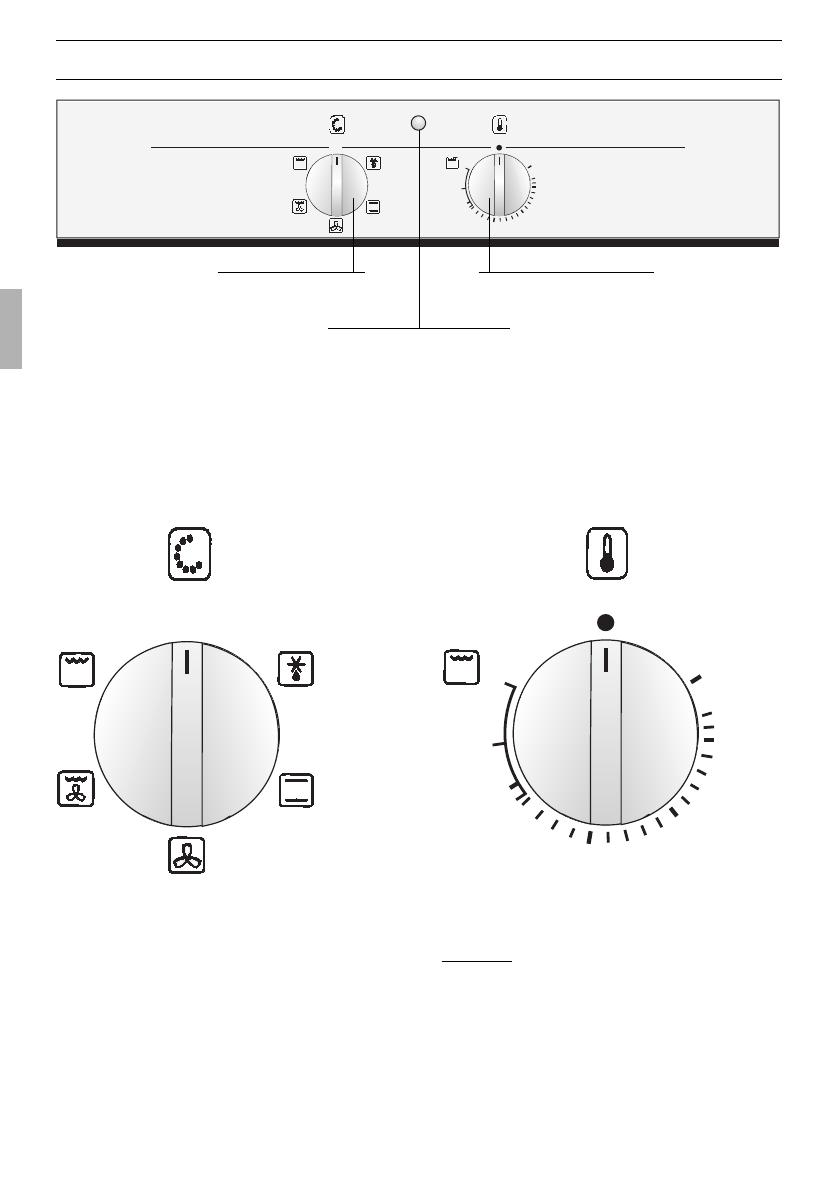
50
100
150
200
0
1
250
2
3
0
50
100
150
200
250
1
2
3
Introducing: Your new Cooker
30
Settings:
50–275 Temperature in °C
1 – 2 – 3
Grill stages
Settings:
k ”Defrost” setting
t top/bottom heat
‰ hot air
ˆ Circulating air grilling
x Grilling
Function selector Temperature selector
Temperature selector
Oven temperature
control lamp
Function selector
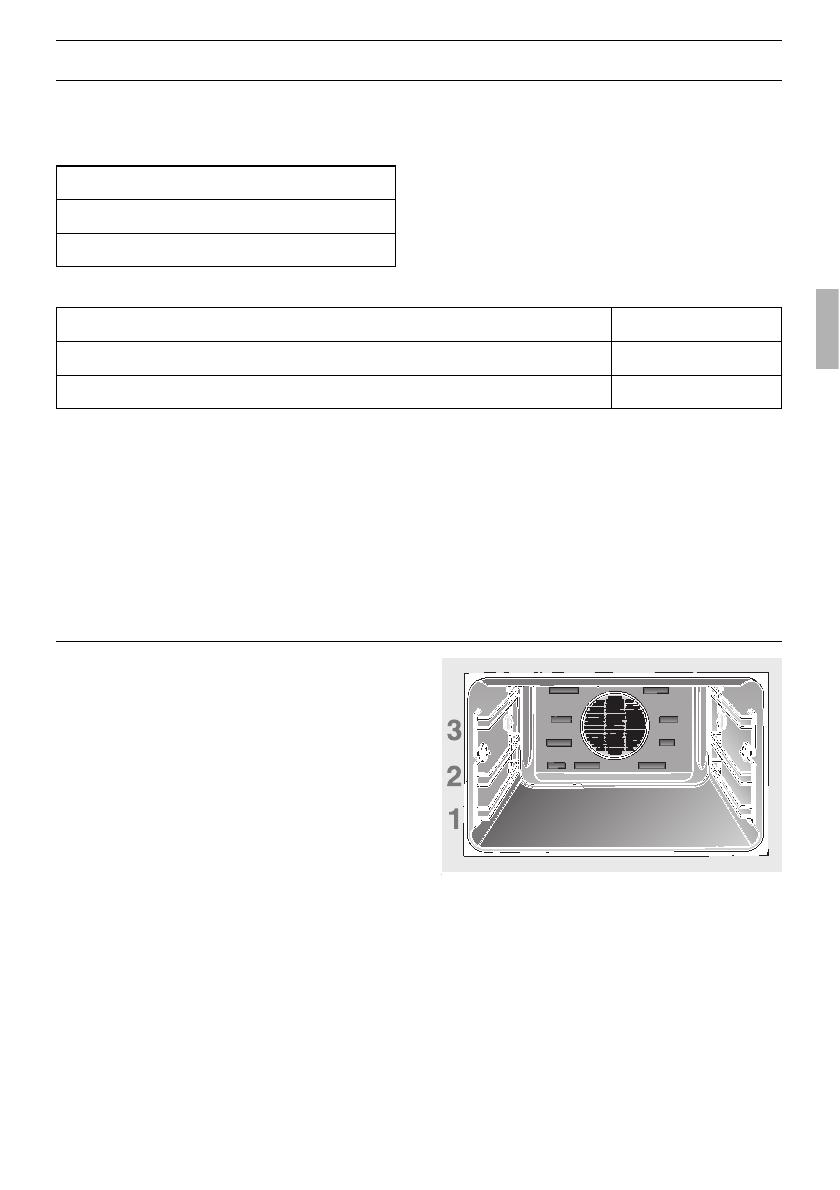
31
Introducing: Your new Cooker
Slide-in levels
❑ Your oven features 3 slide-in levels.
The slide-in levels are counted from
bottom to top. The numbers are marked
in the oven.
When using hot-air baking or
roasting, do not use slide-in level »2«,
in order not to block air circulation.
Accessories
❑ Your appliance is supplied with:
Order no.
Baking tray, aluminium
Wire shelf, high/low
Wire shelf, close mesh
HEZ 5100
HEZ 5141
HEZ 5142
❑ The following accessories can be obtained from a specialist dealer:
1 Baking tray, aluminium
1 Wire shelf
1 Universal pan
Notes:
❑ The guard prevents contact with the hot
oven door.
❑ This is particularly important with small
children.
❑ The baking tray or universal pan may
distort while the oven is operating. This
is caused by major temperature
differences on the utensil. These
differences may occur if only one part of
the utensil was covered or if deep-frozen
food, e. g. pizza, was placed on the
utensil.Note:
The distortion will already subside again
during baking, roasting or grilling.

32
Description of Oven Features
”Defrost” setting ————————— k
Without temperature.
Recommended for delicate bakeware only
(i.e., whipped-cream gateaus).
Top and bottom heat ———————
t
The heat is generated through radiators
situated above and below in the oven and
transmitted to the food being baked and
cooked by radiation.
– Particularly suited for roasting and
baking on one level, for sensitive baked
goods and lean meat cuts and bread.
– Use only one insertion level.
We recommend:
Insertion level 1 or 2.
– For further details see baking and
roasting tables.
Hot air —————————————
‰
The hot air in the oven is circulated by a
blower located in the rear wall of the oven,
which causes a particularly good heat
transmission to the food being baked and
roasted.
– Particularly suite for thawing and baking
also simultaneously at several levels.
– Ideally usable for certain baked goods
like Pizza, yeast twist or cream puffs.
– Do not use insertion level 2, to avoid
impairing the air circulation.
Circulating air grilling ——————— ˆ
The combination between grill and blower.
– Particularly suited for grilling fat meal
cuts and poultry.
– Circulating air grilling with closed oven
door (energy-saving).
– Use only one insertion level.
We recommend:
Insertion level 1 or 2.
– For further details see roasting tables.
Grill ——————————————
x
The heat is generated by the radiator and
transmitted to the food being grilled by
radiation.
– Particularly suited for flat grilled foods
like chops, steaks or toast.
– Grilling with closed oven door (energy-
saving).
– Use only one insertion level.
We recommend:
Insertion level 2 or 3.
– For further details see grilling table.
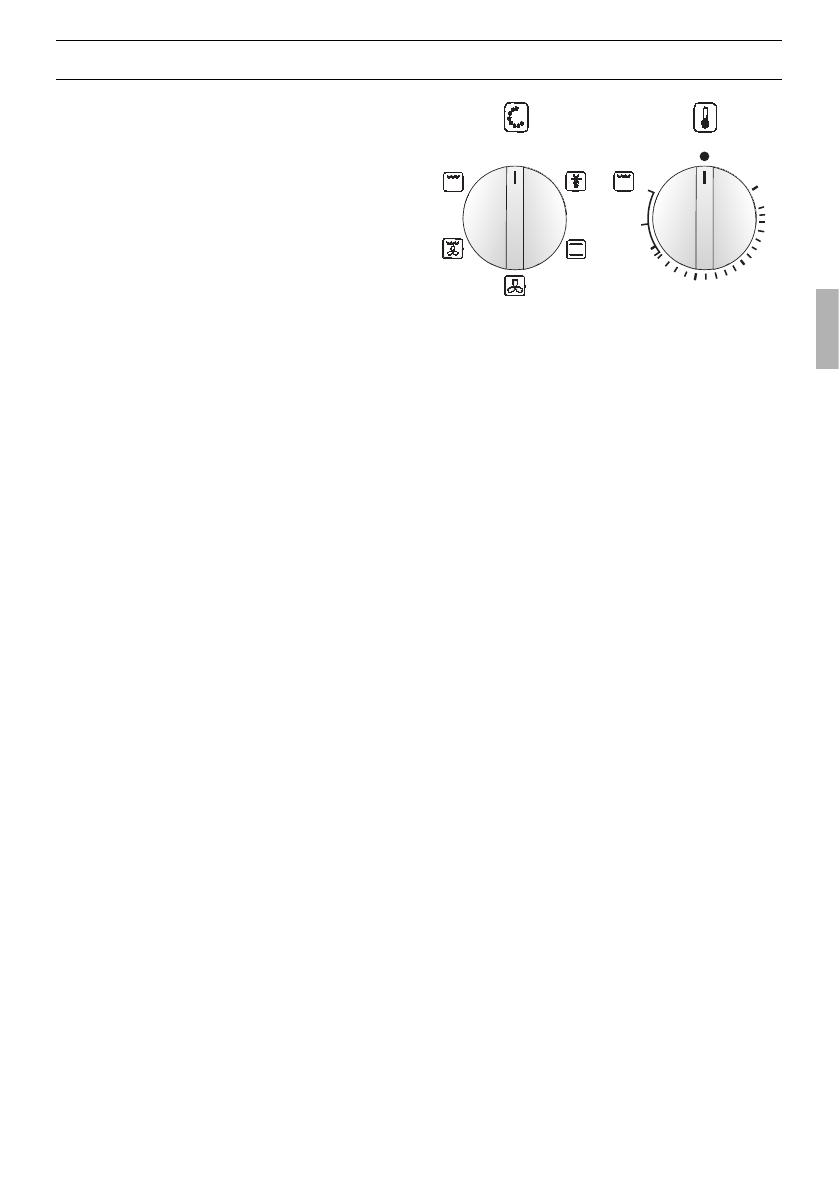
33
Switching the Oven ON and OFF
Before switching on your oven, you should
decide which heating system you wish to
use.
Switching the oven ON:
1. Use the function selector to determine
the desired system.
2. Set the temperature control knob to the
desired temperature (see baking and
roasting table).
❑ The selected temperature will be
controlled automatically.
❑ The red oven temperature control lamp
illuminates when the oven is first
switched on, and extinguishes when the
required temperature has been reached.
Switching the oven OFF:
To switch the oven OFF, turn both the
temperature selector and function selector
to the »0« position.
Function selector Temperature
selector
0
50
10
0
150
200
250
1
2
3

34
Baking
t
Top and bottom heat
1. Set Function selector to t.
2. Set temperature selector.
❑ We recommend dark browning forms.
❑ The browning result can be influenced
by changing the insertion level heights.
❑ Always place baking sheets in the
middle of the grate.
❑ Cakes and biscuits can be placed in
the cold or warm oven.
❑ If the oven is preheated, the baking
times are shortened by around
5 minutes.
❑ Bevel of the baking sheet must always
face the oven door.
❑ Always shove baking sheet up to the
stop.
Tips:
❑ If a cake falls during baking or after it is
taken out, use less liquid next time, set
the temperature lower and possibly
select a longer baking time.
❑ Cake too dark on the bottom:
Check insertion height. Shorten baking
time, possibly select a lower
temperature.
❑ Cake too light on the bottom:
Check insertion height, possibly select
lower temperature and lengthen baking
time and use a black baking sheet if you
did not do so before.
0
50
100
150
200
250
1
2
3
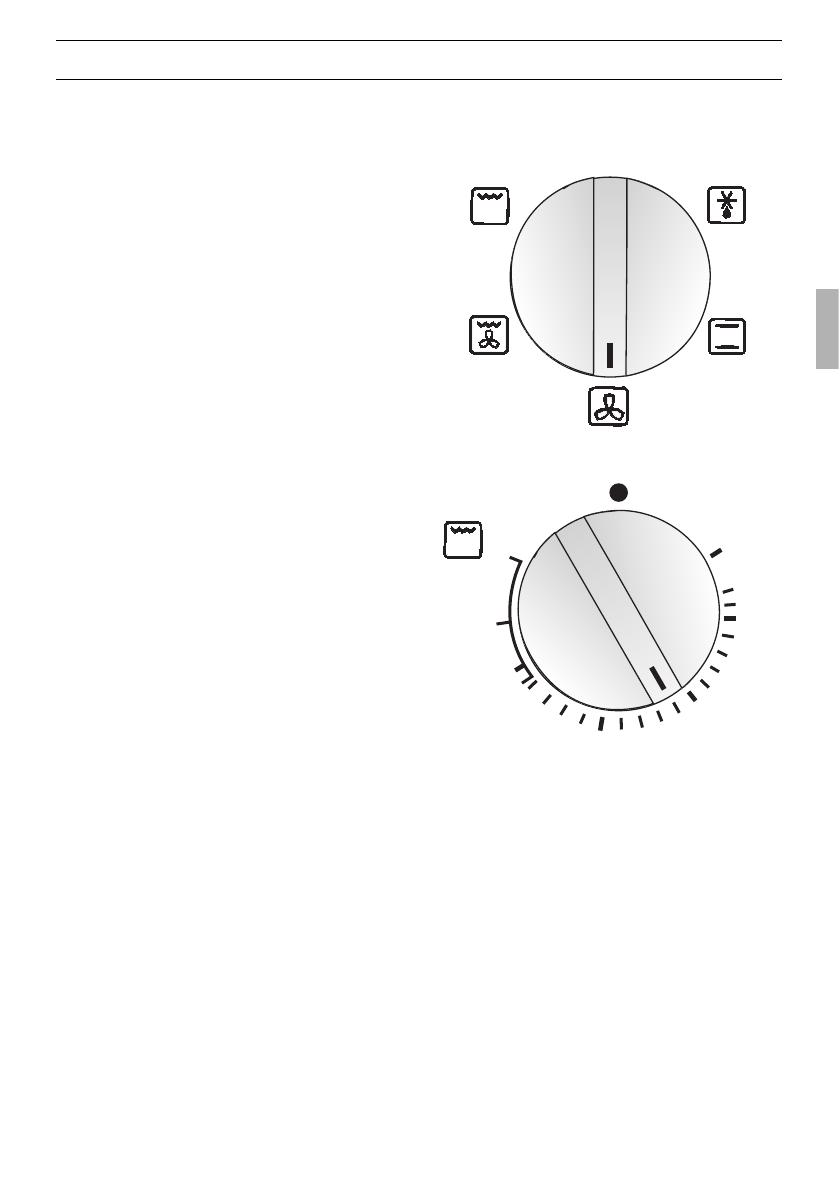
35
Baking
‰
Hot air system
1. Set Function selector to ‰.
2. Set temperature selector.
❑ As a rule, preheating is not necessary.
❑ Depending on what is being baked, you
can bake on up to 2 baking this at one
time. For this, selected insertion level 1
and 3. No problems arise even if you
use a great variety of baking or roasting
utensils.
Attention!
❑ If you use hot air, a temperature
setting 20 to 30 degrees lower can be
selected, compared to top and bottom
heating.
❑ The lower temperature always produces
more uniform browning.
❑ The bevel of the baking sheet must
always face the oven door.
❑ Shove baking sheets always up to the
stop.
❑ Always place baking sheets on the
middle of the grate.
❑ For cake in tins:
Insertion level 1.
❑ For flat cakes, fruit cakes, biscuits,
pizza and the like:
Insertion level 1.
❑ 2 sheets:
Insertion level 1 and 3.
0
50
100
150
200
250
1
2
3

36
Baking table ‰ or t
Note:
❑ All figures indicated in the table are recommended values only and may vary depending
on the quality of the food.
Hot air ‰ Top/bottom heat t
Type of cakes Shelf Temperature baking time Shelf Temperature
and pastries height in ° C in minutes height in ° C
Cake mixtures
Cake on baking sheet
with topping
1 baking sheet (preheat) 1 150 – 160 30 – 45 1 180 – 190
2 baking sheets (preheat) 1 + 3 150 – 160 35 – 50 – –
Square cake 1 150 – 160 60 – 80 1 160 – 170
Round cake 1 150 – 160 60 – 80 1 160 – 170
Tall cake 1 150 – 160 60 – 80 1 160 – 170
Fruit flan base (preheat) 1 150 – 160 20 – 35 1 160 – 170
Short pastry
Cake on baking sheet
with crumble mixture
1 baking sheet 1 160 – 170 50 – 80 1 180 – 190
2 baking sheets 1 + 3 160 – 170 65 – 80 – –
Cake on baking sheet
with moist topping
(e.g. cream) 1 150 – 160 50 – 90 1 170 – 180
Cake in tin
(e.g. cheesecake) 1 150 – 160 70 – 100 1 160 – 170
Fruit flan base (preheat) 1 150 – 160 25 – 35 1 180 – 190
Sponge mixture
Swiss roll (preheat) 1 180 – 190 10 – 15 1 200 – 220
Water biscuit 1 150 – 160 30 – 45 1 150 – 160
Fruit flan base 1 150 – 160 25 – 35 1 160 – 170

37
Baking table ‰ or t
Hot air ‰ Top/bottom heat t
Type of cakes Shelf Temperature baking time Shelf Temperature
and pastries height in ° C in minutes height in ° C
Yeast dough
Cake on baking sheet
with crumble mixture
(e.g. apple crumble)
1 baking sheet 1 160 – 170 45 – 55 1 180 – 200
2 baking sheets 1 + 3 160 – 170 60 – 70 – –
Cake on baking sheet
with moist topping
(e.g. cream) 1 160 – 170 50 – 60 1 180 – 190
Plaited bun,
500 grams flour 1 160 – 170 40 – 50 1 180 – 190
Round cake 1 160 – 170 40 – 50 1 170 – 180
Tall cake 1 160 – 170 40 – 50 1 170 – 180
Biscuits
Meringue 1 080 – 100 120 – 140 1 170 – 080
Puff pastry (preheat) 1 180 – 200 25 – 35 1 200 – 220
Choux pastry (preheat) 1 180 – 190 30 – 40 1 200 – 220
Viennese whirl
1 baking sheet 1 140 – 150 30 – 45 1 150 – 160
2 baking sheets 1 + 3 140 – 150 30 – 45 – –
Cake mixtures
(Small Cakes) 1 150 – 160 30 – 40 1 160 – 170
Savoury dishes
Soufflé consisting
of raw ingredients 1 170 – 180 60 – 75 1 190 – 200
Pizza 1 180 – 190 25 – 45 1 210 – 230
Quiche (preheat) 1 180 – 190 40 – 50 1 190 – 210
Bread, 1 kg (preheat)
Start baking 1 220 10 – 15 1 240
Finish baking 1 180 40 – 45 1 200
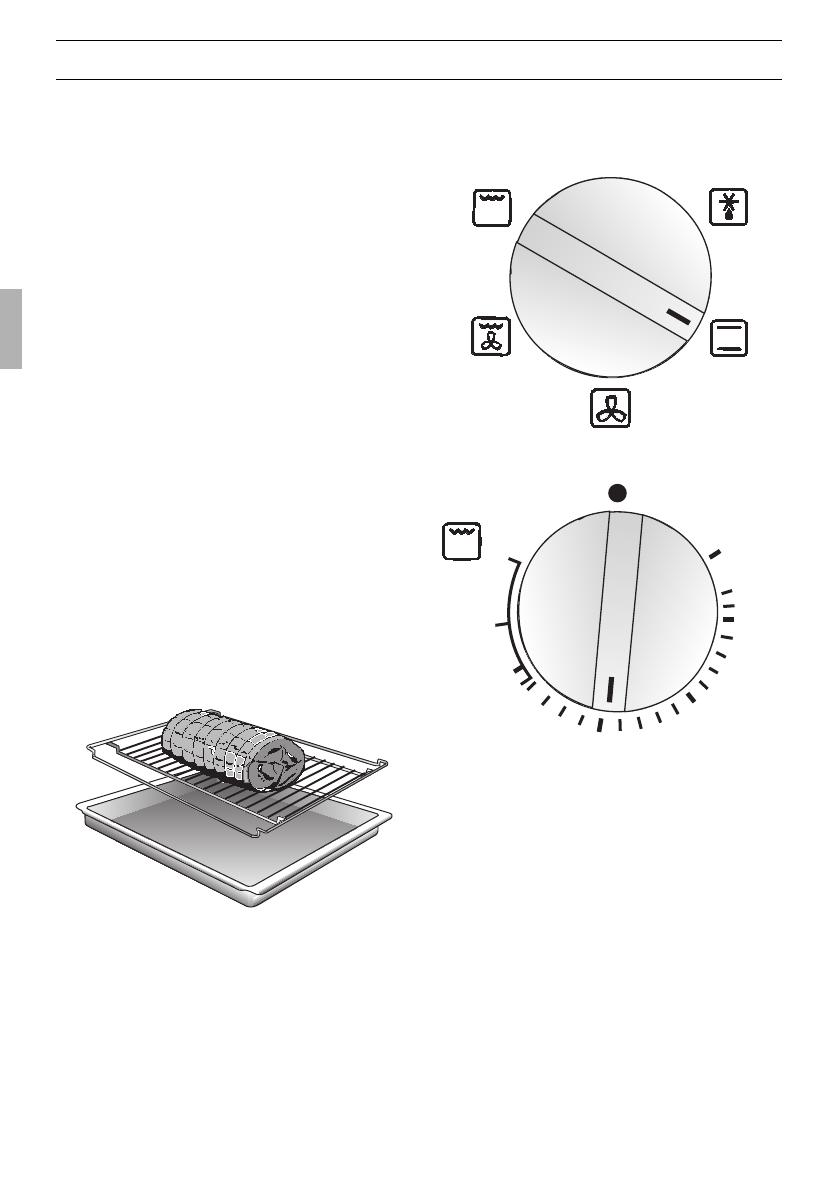
38
Roasting
t
Top and bottom heat
1. Set Function selector to t.
2. Set temperatur selector
❑ Shove roast into the cold oven
(preheating unnecessary
– energy saving –).
❑ Roasting in an open vessel:
Rinse out the roasting pan or the
roasting vessel with water and place the
meat into it. The insertion level depends
on the size and thickness of the roast.
❑ Roasting in a closed vessel:
Place the meat into a roasting pot, cover
with a fitting lid, and slide it on the grate
into the oven. Set the oven temperature
around 20 – 30° C higher.
❑ Use only roasting vessels with heat-
resistant handles, for example, enamel,
glass or cast-iron roaster.
❑ Always prepare poultry only after it has
been completely thawed. Remove the
entrails beforehand and clean the
poultry thoroughly.
❑ After the roasting time has expired, leave
the roast for around 5 minutes in the
switched-off oven.
0
50
100
150
200
250
1
2
3
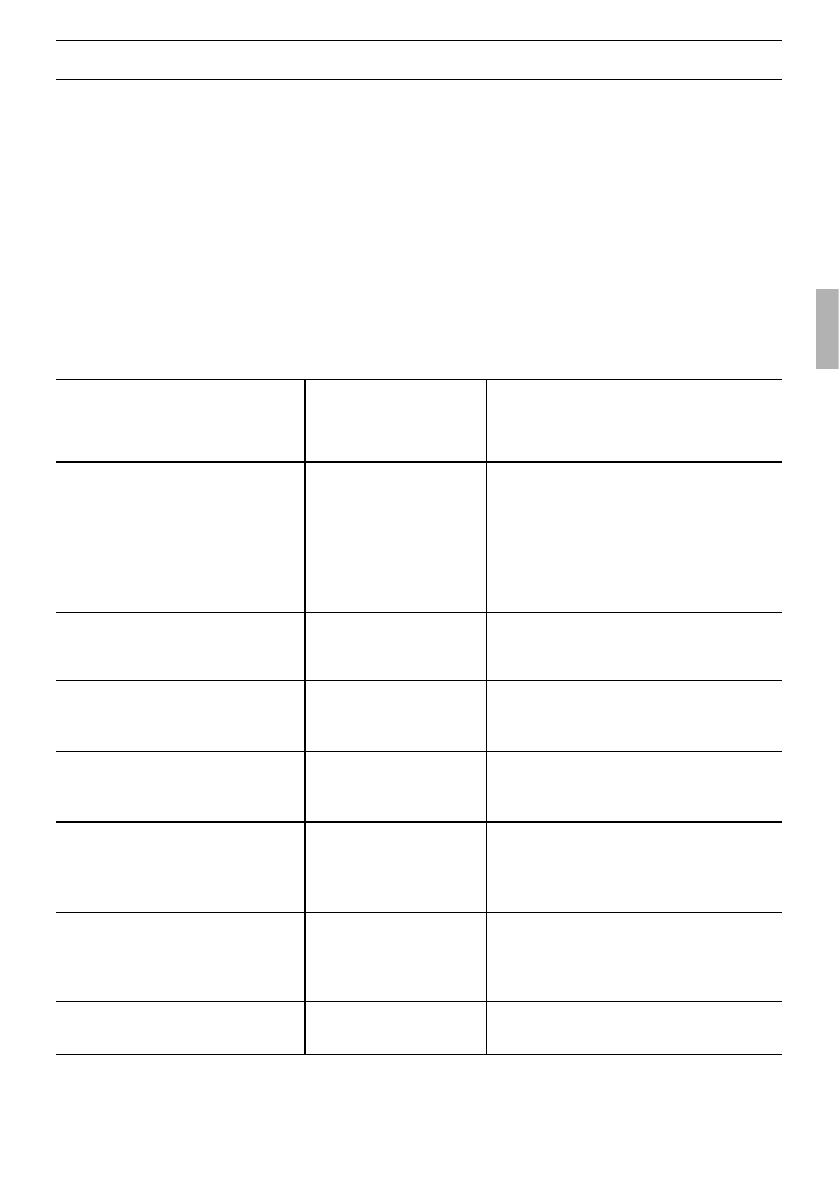
39
Note:
❑ Roast in open casserole dish on wire shelf.
❑ Shelf height 1
large, solid pieces of meat = longer roasting time, lower temperature.
Flat pieces of meat = shorter roasting time, higher temperature.
❑ The roasting time does not change considerably if two approximately equally large
pieces of the same type of meat are roasted simultaneously.
❑ All figures indicated in the table are recommended values only and may vary depending
on the quality of the food.
Roasting table
top/bottom heat
t
Type of meat Roasting time Shelf Temperature
in minutes height in ° C
Pork
Joint with skin,
2 kg (e.g. shoulder or knuckle) 140 – 160 1 180 – 200
Joint 90 – 120 1 180 – 200
Smoked pork 70 – 80 1 180 – 200
Fillet of pork 40 – 50 1 200 – 220
Meat loaf, 750 grams 60 – 70 1 180 – 200
Beef
Fillet 45 – 65 1 190 – 210
Sirloin (medium-rare) 35 – 45 1 190 – 210
Veal
Joint / breast 90 – 120 1 180 – 200
Knuckle 100 – 130 1 190 – 210
Lamb
Leg 70 – 110 1 190 – 210
Saddle 90 – 120 1 190 – 210
Poultry
Chicken, 1 kg 60 – 70 1 190 – 210
Duck, 2 – 2,5 kg 90 – 120 1 180 – 190
Goose, 3 kg 130 – 170 1 160 – 180
Game
Saddle of venison 80 – 100 1 190 – 210
Roast venison 90 – 120 1 180 – 200
Roast pork 100 – 120 1 180 – 200
Fish, whole,
1 kg 40 – 50 1 180 – 200
Roasting table
t

40
Circulating air grilling
ˆ
For poultry and larger meat cuts.
Always gril with circulating air with
! closed oven door.
❑ It is not necessary to turn the food being
grilled when you use circulating air
grilling.
Exception: Poultry must be turned once
after half at the cooking time has
expired.
1. Set Function selector to
ˆ.
2. Set temperature selector between 160
and 220 depending on the type of meat
and its size.
Grilling on the grate:
❑ Insert grate with meat to be grilled into
the suitable insertion level.
❑ Always place universal drip pan into
the proper insertion level.
❑ Dark meat – e. g. from beef, game and
mutton – browns more quickly than light
meat from veal, pork and poultry.
❑ Light meat and fish fillet are often only
light brown on the surface, but done
and juicy inside.
❑ Several pieces of meat can be grilled at
the same time, e. g. 2 chickens, 2
knuckles or two rolled roasts.
❑ For large or several pieces of meat, the
following always applies:
lower temperature, and longer grilling
time.
Note: With circulating air grilling, the
blower is alternately switched on and off.
0
50
100
150
200
250
1
2
3

41
Table for circulating air grilling
ˆ
Note:
❑ All figures indicated in the table are recommended values only and may vary depending
on the quality of the food.
Type of meat Weight Shelf height Temperature Grill time Tips
for range in min.
wire shelf in °C
Pork
Joint with skin 2 kg 1 170 – 190 140 – 150 If the joint is
especially fatty,
select a lower tem-
perature. Make
crosses in the skin
with a knife.
Poultry
Half chicken Approx. 2 190 – 210 040 – 050 After approx. half
1–3 pieces 0.4 kg/piece the cooking time,
turn once; coat with
butter or salt water.
Whole chicken
1–3 pieces Approx. 1 190 – 210 060 – 070
1 kg/piece
Duck 2 – 2,5 kg 1 160 – 170 090 – 110
Goose 3 kg 1 150 – 160 130 – 160 Stuffed goose can
also be grilled.
Turn once.
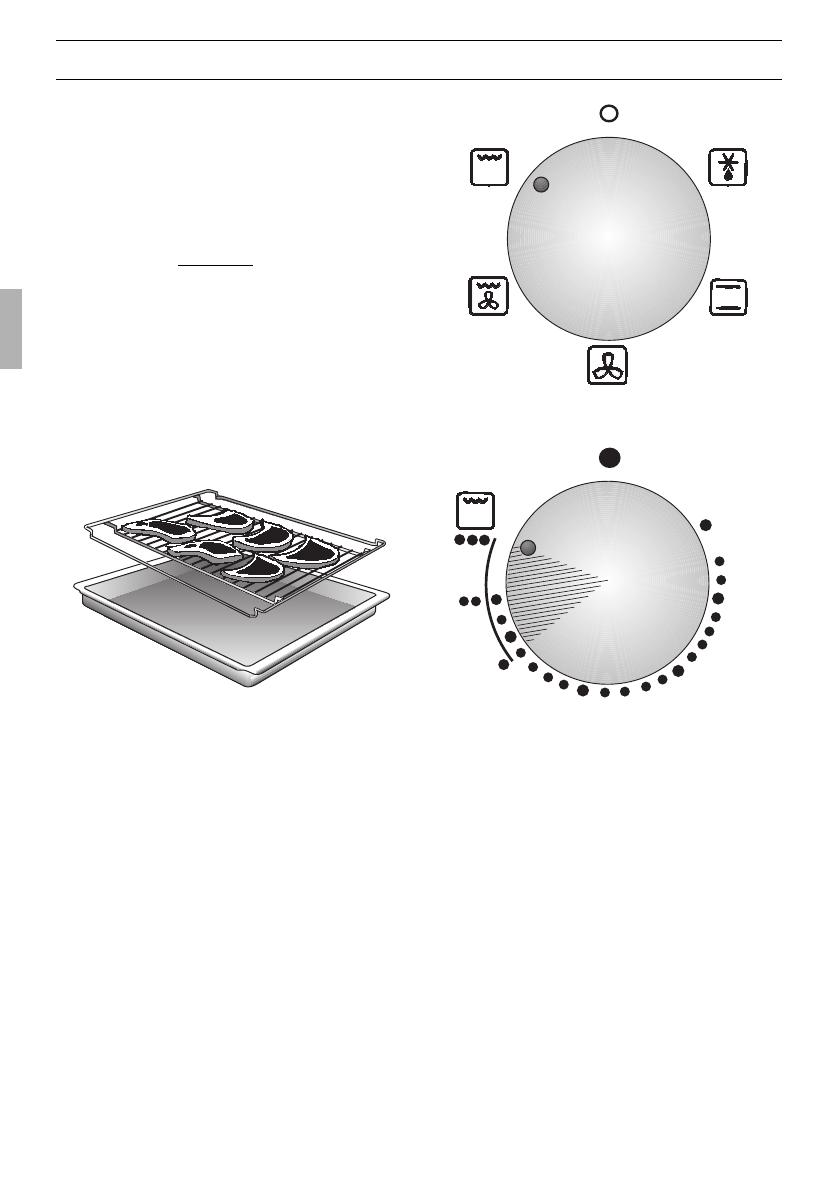
42
Grilling
x
Be careful when you grill.
! Always keep children away!
Grill with
! closed door.
1. Set Function selector to
x.
2. Set temperature selector:
Grill stages 1 – 2 –
3.
Grilling:
(only with grate and universal drip pan)
❑ Brush the grate with oil as required.
❑ Dab off food to be grilled dry and spice
(do not salt).
❑ Place grate with food to be grilled into
the corresponding insertion level.
❑ Always place universal drip pan into
the proper insertion level.
❑ If you turn over the concave grate,
you can make a fine adjustment of the
insertion height (intermediate heights).
❑ Meat up to 3 cm thickness (rare steaks)
at insertion level 3.
❑ Sausages at insertion level 2 or 3.
❑ Fish (trout) or thick cuts of meat well
done at insertion level 2.
Guides for grilling times: (Examples)
Meat well done 6-8 Min. per side,
Meat pink inside 4-6 Min. per side,
Fish in slices 6-8 Min. per each side,
Trout 6-10 Min. per side,
Sausages 3-5 Min. per side.
Note: If the grill switches off automatically,
the desired temperature has been reached.
After a short time, the grill switches on
again.
200
50
100
150
250
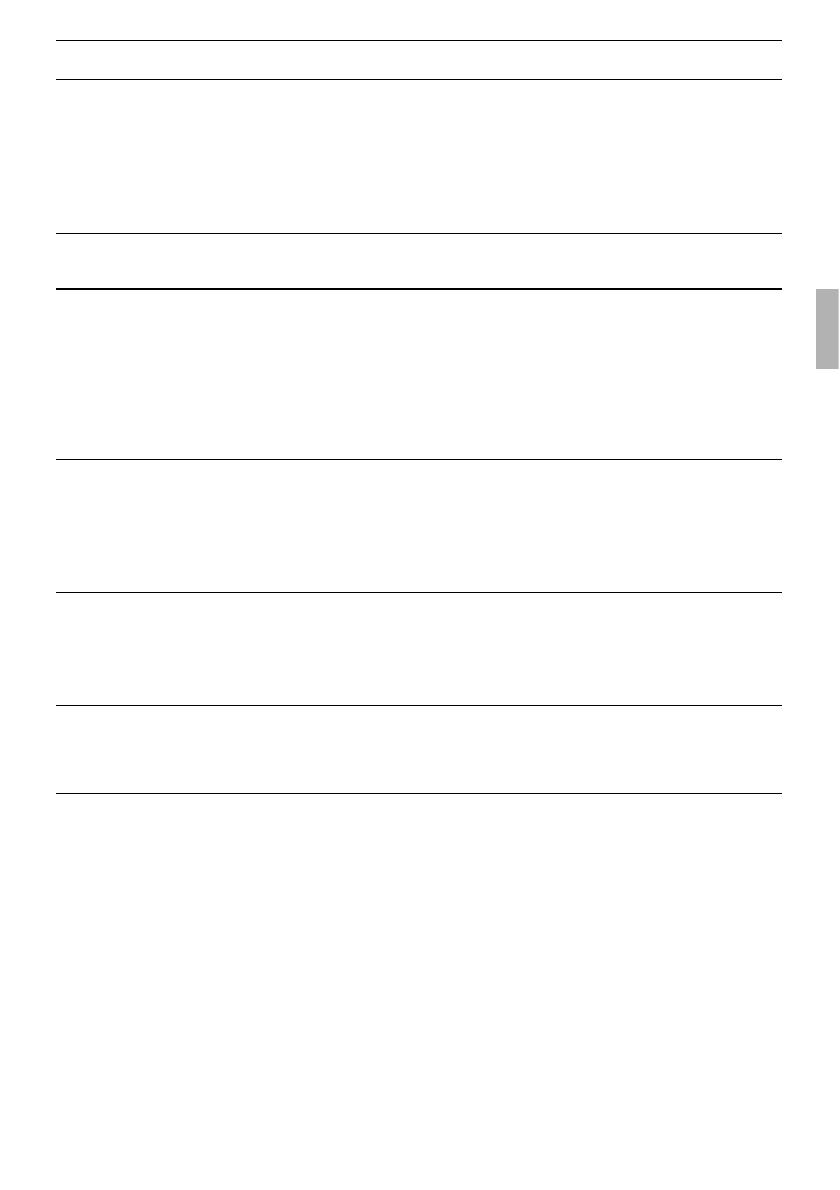
43
Grill table
x
Notes:
❑ Always insert the universal pan at shelf height 1.
❑ All figures indicated in the table are recommended values only and may vary depending
on the quality of the food.
Dish Shelf height Grill setting Side Grilling time
in minutes
Pork
Fillet steak 3 3
1st side 08–11
2nd side 04–06
Neck of pork steak 3 2 – 3
1st side 10 – 13
2nd side 07–10
Sausage 2 – 3 2 – 3
1st side 07–10
2nd side 05–07
Beef
Fillet steak 3 3
1st side 10 – 13
2nd side 04–07
Tournedos 3 3
1st side 18–11
2nd side 04–06
Toast
Without topping 3 3
1st side 4
1
/
2
–5
1
/
2
2nd side 0
1
/
2
–1
1
/
2
With topping 2 – 3 1 – 2 – 18–12
Fish
Small fish
2 1 – 2
1st side 12 – 15
(250 – 300 g) 2nd side 05–10
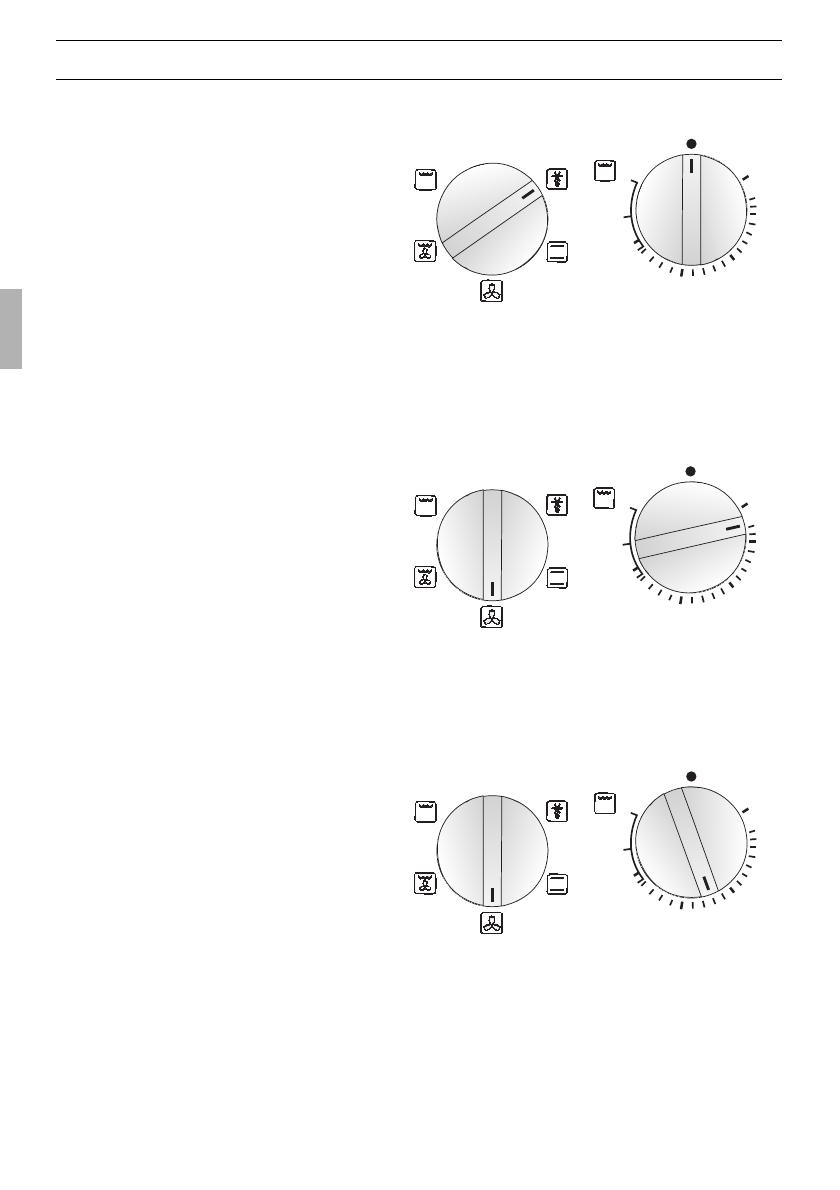
44
Thawing / Drying / Heating
‰
”Defrost” setting
(without temperature):
1. Set Function selector to
‰.
❑ For sensitive frozen food such as cream
cakes, butter cakes, cream cakes with
chocolade or sugar glazings, fruit, brawn
and the like, 1 or 3.
❑ Place frozen food in vessel (e. g.
porcelain bowl) on the grate.
Hot air system with
temperature:
1. Set Function selector to ‰.
2. Set temperature selector.
❑ Fryingens, sausages and meat in foil,
bread, rolls cakes and other pastries:
Insertion level 1.
Temperature selector at 50 to 70.
Ready-to-serve meals:
❑ Do not open the aluminium foil package
or thaw in closed vessel.
Set oven temperature selector to 160 –
180 (ready to eat after 30 to 40
minutes).
❑ Insertion level 1.
0
50
100
150
200
250
1
2
3
0
50
100
150
200
250
1
2
3
0
50
100
150
200
250
1
2
3

45
Instruction:
❑ All table values are guide figures which can vary depending on the condition of the food.
Thawing:
Frozen food Insertion Temperature Thawing time
level range in °C in minutes
Sensitive frozen food like cream 1 Select function individual pieces of cake
and butter cream cakes
1)
,
‰
(without 30 – 040
cakes with chocolate or sugar temperature
whole or half cream cakes
galzings
1)
switching) 80 – 100
Fruit (rashberries)
2)
35 – 040
Brawn
2)
, cheese, sausages 90 – 100
Small meat cuts 1 050 – 070 60 – 070
e. g. steaks, chops and the like
Chicken in foil
1)
, 800 – 900 g 70 – 080
Rolls
1)
1 060 – 080 10 – 015
Bread, 1 kg
1)
70 – 090
Cake (bowl cake)
1)
70 – 090
Ready-to-serve meals 1 170 – 190 30 – 040
1)
Place or lay on the grate.
2)
Put on a flat dish or plate and place on the grate.
Drying:
Dried food, amount Insertion Temperature Drying time
level range in °C
Apple rings, 600 g 1 + 3 around 50 6 – 08 hours
Pear sections around 800 g 1 + 3 around 50 9 – 11 hours
Plums or damsons, 1 + 3 70 – 100 9 – 12 hours
around 1,5 kg
Bananas, 300 g 1 + 3 around 50 8 – 10 hours
Mushrooms, 800 g 1 + 3 50 – 60 7 – 09 hours
Kitchen herbs, 400 g 1 50 – 60 3 – 05 hours
(bundles)
Table Thawing / Drying
‰

46
Cooking Tips and Helpful Hints
To save energy:
❑ Preheat only if expressly required by the
recipe.
❑ Dark baking tins have a higher degree of
heat absorption.
❑ Residual heat: In the case of longer
baking times, you can switch off the
oven 5 – 10 minutes before the full
baking time has elapsed.
For baking:
❑ The bottom of a cake baked on a
baking sheet stays too light.
❑ The bottom of a cake baked in a tin
stays too light.
❑ The bottom of cake or cookies gets too
dark.
❑ The cake gets too dry.
❑ The inside of the cake remains spongy
or doughy, or meat stays raw in the
centre.
❑ With very moist baked or roasted
goods: For example, when making fruit
pie or a water-basted roast, steam
develops, condenses on the oven door,
and may cause water to drip onto the
floor or into the modular furniture
enclosing the appliance.
Remove from the oven all baking sheets or
universal baking pan currently not in use.
Use a grill and not a baking sheet to
support the cake tin during baking.
Select a slightly lower baking temperature
and check the shelf height.
Select a slightly higher oven temperature,
and shorter baking time.
Use a slightly lower baking or roasting
temperature.
Note: Baking or roasting times cannot be
shortened by using higher temperatures
(done on the outside, raw inside). Select a
slightly longer baking or roasting time, allow
cake dough more time to rise. Reduce the
amount of liquid used in the dough.
Several brief periods of opening the oven
door during baking (1 to 2 times, more
frequently with longer roasting times) will
aid in venting the water vapours from the
oven, thereby greatly reducing water
condensation.
/